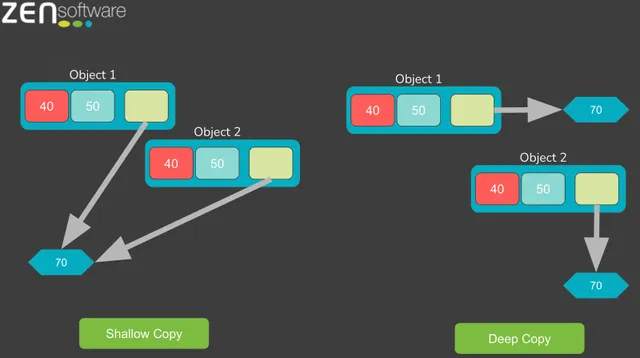Implementing a copy constructor for Java, Python, Golang and Rust

A copy constructor is a special type of constructor in object-oriented languages like C++ and Java that creates a new object by initializing it with an existing object. The copy constructor is used to create a copy of an object in a way that is independent of the original object, meaning that changes made to the copy do not affect the original.
If you forget to implement a copy constructor and use the default constructor provided by the programming language, the copy constructor will perform a shallow copy.
A shallow copy copies the values of the data members of the original object to the new object, but if the data members contain pointers, the pointers will be copied, not the values they point to. This means that the new object will point to the same memory location as the original object, and if you modify the new object, you will also modify the original object. This can lead to memory leaks, crashes or all sorts of nasty bugs.
A deep copy is a type of copy operation in programming that creates a new object with the same values as an existing object but with separate memory locations. In a deep copy, all the data members of the original object are copied, including the values of any pointer variables or reference types. This means that any changes made to the copied object will not affect the original object and vice versa.
Scenarios
In the Shallow Copy scenario below (left) you see the Pointer to the location ‘70’ being referenced by both Object 1 and Object 2. Changing the value on object 1 will influence object 2 also. freeing object 1 will create a problem (crash) for object 2 when it references a dereferenced memory location.
In the Deep Copy scenario the content of the object ‘70’ is copied and given a location of its own. Object 1 and Object 2 are now completely separate and cannot, negatively, influence each other.

Shallow copy vs Deep copy of an object
Copy constructor’s origins in C++
In C++, the copy constructor is mandatory because C++ generates a default copy constructor if one is not defined. This default constructor performs a shallow copy of the object. This can lead to issues if the object contains pointers or dynamic memory allocations, as the shallow copy will copy the pointer instead of the actual data.
The copy constructor in C++ works by taking a reference to an existing object and creating a new object that is a copy of the original. It can be defined as follows:

a different constructor
1class MyClass {
2public:
3 // Default constructor
4 MyClass();
5
6 // Copy constructor
7 MyClass(const MyClass& other);
8};
9
10// Implementation of copy constructor
11MyClass::MyClass(const MyClass& other) {
12 // Copy data members from 'other' to 'this'
13}Python
In Python, a copy constructor is not mandatory as Python provides a built-in copy module that provides functions for creating copies of objects. However, in certain scenarios, such as when working with mutable objects like lists or dictionaries, a copy constructor can be useful. An example implementation of a copy constructor in Python is as follows:
1class MyClass:
2 def __init__(self, value):
3 self.value = value
4
5 # Copy constructor
6 def __init__(self, other):
7 self.value = other.valueJava
In Java, a copy constructor is critical when you need to create a deep copy of an object. If the object contains mutable objects, then the default copy constructor will not create a copy of the mutable object but rather a copy of its reference, leading to issues if the original object is modified. An example implementation of a copy constructor in Java is as follows:
1public class MyClass {
2 private int value;
3
4 // Default constructor
5 public MyClass(int value) {
6 this.value = value;
7 }
8
9 // Copy constructor
10 public MyClass(MyClass other) {
11 this.value = other.value;
12 }
13}Golang
In Go, a copy constructor can be implemented by defining a new function that takes a pointer to an existing object and returns a new object that is a copy of the original. The new function can be defined as follows:
1type MyClass struct {
2 value int
3}
4
5// Copy constructor
6func NewMyClass(other *MyClass) *MyClass {
7 return &MyClass{value: other.value}
8}In Go, a copy constructor is not as commonly used as in other languages since Go provides a built-in mechanism for copying values using the = operator. When a value is assigned to a new variable, a new copy of the value is created. However, if the struct contains pointer fields, this behavior may not create a deep copy and can lead to unexpected behavior.
Therefore, a copy constructor in Go can be useful when you need to create a deep copy of a struct that contains pointer fields or when you want to define a specific way to copy a struct. For example, if a struct contains a map or a slice, using the = operator to copy the struct will create a new copy of the reference to the map or slice, but not a new copy of the data itself. In this case, a copy constructor can be used to create a new copy of the data.
1type MyClass struct {
2 values []int
3}
4
5// Copy constructor
6func NewMyClass(other *MyClass) *MyClass {
7 values := make([]int, len(other.values))
8 copy(values, other.values)
9 return &MyClass{values: values}
10}While a copy constructor is not as common in Go as in other languages, it can be useful when you need to create a deep copy of a struct that contains pointer fields or when you want to define a specific way to copy a struct.
Rust
In Rust, a copy constructor is not needed as Rust uses ownership and borrowing to ensure memory safety. However, Rust provides a Clone trait that can be used to create a copy of an object. An example implementation of Clone in Rust is as follows:
1#[derive(Clone)]
2struct MyClass {
3 value: i32,
4}
5
6fn main() {
7 let a = MyClass { value: 42 };
8 let b = a.clone(); // Creates a copy of 'a'
9}Conclusion
In summary, a copy constructor is used to create a new object by initializing it with an existing object. It is mandatory in C++ to ensure that a deep copy is performed, while in Python, Java, and Rust, it is not always necessary but can be useful in certain scenarios.

Optimize with ZEN's Expertise
Upgrade your development process or let ZEN craft a subsystem that sets the standard.
Read more:

Implementing a copy constructor for Java, Python, Golang and Rust
A copy constructor is a special type of constructor in object-oriented languages like C++ and Java that creates a new ob...

Coding on Holiday - Hacking Huawei MiFi
Back in 2014 i bought a Huawei B593s-22 which would allow me to be able to work non office locations using WiFi. So usi...

AI is the missing piece of the Productivity Puzzle
Today, I’d like to plea that Artificial Intelligence (AI) is the missing piece of the productivity puzzle, revolutionizi...

Say Goodbye to Frustration: ZEN Software's Plugin Makes Picture Labeling a Breeze!
WordPress empowers businesses, creative enthusiasts, and content creators with its user-friendly interface and extensive...

Programmer frustration: Yak Shaving
The term "yak shaving" in programming originated from an episode of the popular 1990s cartoon "Ren & Stimpy." The episod...

Amazon Prime Video swaps Microservices for Monolith: 90% Cost Reduction
Recently, Amazon Prime Video published a surprising article [revealing how they saved 90%](https://www.primevideotech.co...
